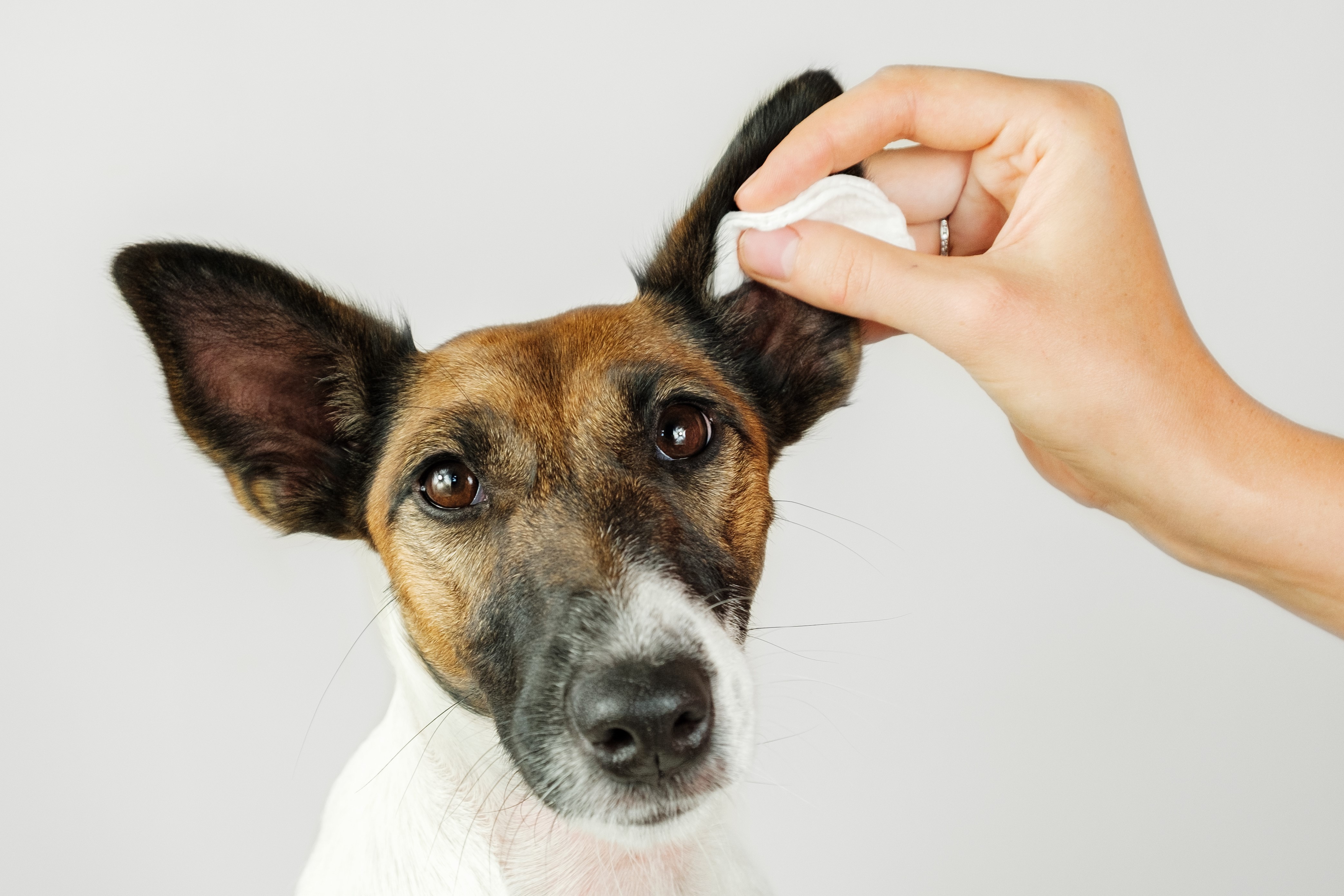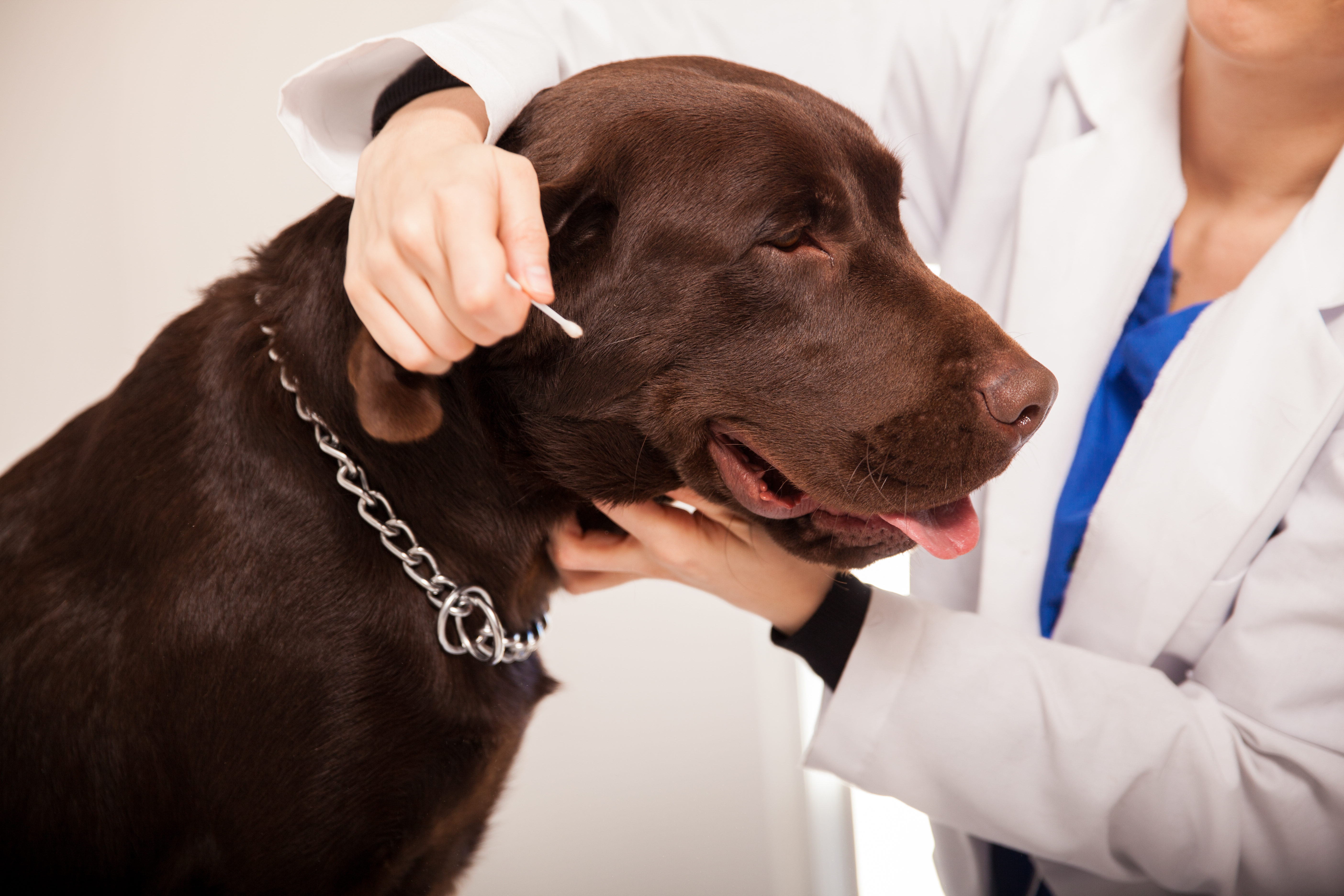
There are a couple of smells that any pup owner learns to dread if they start to get a whiff: bad breath, anal glands, and dirty ears.
Now, while we’ll have to leave anal glands and dental care for another day, we are going to chat about ears.
In this article, we’re going to talk about why ears get dirty, how and why ear infections occur, and most practically, how and when to clean your pup’s ears in a safe and effective way. And lastly, what do you do if your dog hates ear cleaning?
Why Do Ears Get Dirty?
It’s important to note that we’re considering “dirty” ears and actual ear infections to be different things in this article. We are going to get into ear infections in just a minute, but right now, let’s talk about why more or less healthy and clean dog ears get debris build-up.
Like the rest of the body, the skin of the ear canals have glands all throughout. Glands in the ears produce cerumen, which is a yellow to brown waxy debris. How much cerumen is produced in the ear depends on breed, conformation of the ear, and many other factors.
Just like you or I, regularly cleaning ceruminous debris out of the ears can be beneficial as a grooming practice.
The Dreaded Ear Infection
Some waxy build-up can be normal, but usually ears that just have some ceruminous waxy debris are lacking some of the signs we’ll see in a typical ear infection. Here’s some things to look for when there’s something more serious going on:
- Outer ear and ear canal are red and irritated
- Thick brown to black debris is present
- White, yellow, crusty debris is present
- A foul or sometimes “sweet-smelling” odor is present
If you are appreciating one or more of these signs in your pup’s ears, it’s more likely that an ear infection is occurring.
In the case of an ear infection, cleaning alone is unlikely to resolve the issue. Sometimes, you might be able to stave off a worsening infection by catching it early, but much of the time, you will need to have your pup seen by a veterinarian for appropriate diagnosis and treatment.
What causes ear infections?
Well, there are certain primary and secondary causes that contribute. It is possible to see ear infections only after swimming or bathing. This can occur due to water sitting in the nice, warm environment of the ear canal and allowing infectious organisms, like yeast and bacteria, to grow. Sometimes, other factors contribute, like large floppy ears that trap moisture, or excessive hair growth in the ear canal that traps debris.
Many times, these types of ear infections can be cleared up relatively quickly, in 2 weeks or less. But the important thing to remember is that there should have been an exposure to water within a week to ten days prior. If there’s no water involved, we have to consider another primary cause.
If water is not to blame, the next most common cause of an ear infection is an underlying allergy. This is almost always the case with recurrent infections especially.
Pets can have allergies to environmental allergens like pollens and molds, as well as food protein allergens, like beef or chicken protein. Atopic dermatitis, similar to the condition called eczema in people, is also very common, especially in some dog breeds.
A dog’s skin is flush with immune cells and a very complex pathway of immune response. The presence of allergens lead to a cascade of immune cells flocking to the area, releasing factors to attack the allergens, and resultant inflammation. This is why dogs with allergies can initially get red, itchy ears.
But once the skin gets inflamed, its protective barrier against infectious organisms like yeast and bacteria, starts to fail. And this gets us to our secondary causes, which are those yeast and bacteria. They make early itching and irritation many times worse, leading to more redness and irritation, and even pain.
Veterinarians address ear infections first by resolving the secondary cause. Ear swabs examined under the microscope can help show what type of organisms are involved and helps to select an appropriate ear medication to use.
Certain ear washes are also often prescribed in conjunction with ear medications, as some ear washes have certain properties to assist with the infection.
Once the infection is better controlled, a veterinarian then will work with you and your pup to find out what the underlying, primary cause is. This is often the most challenging part. Allergies can be seasonal or year round. They can be due to food protein allergens only, or in combination with environmental allergens. Figuring all this out can take some time.
Components of addressing the underlying cause of recurrent ear infections can include elimination diet trials, oral medication to block the inflammatory reactions in the skin, or monthly injections that work similarly.
Your vet may also discuss doing allergy testing, the results of which can be used to formulate what is called immunotherapy, or sort of like an allergen vaccine. Small amounts of the allergens your pup is sensitive to can be formulated into a regular oral liquid drop or a weekly shot to help desensitize the body to those allergens. In advanced or refractory cases, your vet may even refer you to a veterinary dermatologist for further investigation.
Many folks wonder if anti-histamines might not just be the simple answer. It’s a fair question. After all, people use anti-histamines all the time for their allergies. But unfortunately, while histamine may be a major player with the runny nose and watery eyes, and it certainly is involved in acute reactions like bee stings, it does not appear to play a major role in the skin allergies of dogs and cats that we’re talking about. Anti-histamines may show benefit in less than about 30% of cases.
It’s also important to remember that people don’t generally get skin allergies. And folks that do get red, irritated skin flare-ups typically have a condition called eczema, also called atopic dermatitis, which is very similar to what our pets can have.
Eczema is an immune condition that typically requires treatment with steroid or immune system modulating medication, and this is far more similar to what dogs get. Anti-histamines are fairly ineffective for people with eczema and the same goes for most dogs with skin allergies.
Eczema also cannot be cured, but can be managed tolerably. The same goes for atopic dermatitis and skin allergies in pets. We can certainly manage the signs pretty well, but break-through flare-ups of ear and skin infections will always happen periodically.
Whew! Ear infections can certainly be complicated. Which is why, if your dog’s ears are showing signs of redness, irritation, pain, or a nasty smell, it’s time to seek help from your vet.

Cleaning the Ears: What to Use
But assuming your furry friend doesn’t have an ear infection, how do you go about regular cleaning?
First we’ll start with what to use as an ear cleaner.
The most important thing, above all else, is to use a product that is developed for use in the ears. The ear canals are very sensitive and have a certain chemical balance that needs to be maintained to prevent abnormal growth.
Avoid home remedies that utilize ingredients like hydrogen peroxide and vinegar. It’s true that these products may kill some growth, but they can be extremely irritating to the ear. Vinegar is extremely acidic and while it may kill some bacteria, your pup’s painful ear will not appreciate it.
We also want to make sure to use a product that will not leave fluid sitting in the ear canal and contribute to more growth problems. Your pup would also prefer something that isn’t going to make her already red, ouchy ears, more irritated. Look for a product that includes language like “cleansing”, “drying”, and “non-irritating”.
You can also find products that contain other beneficial ingredients, like Ear Wash with Aloe Vera and Tea Tree Oil, that can help to soothe a mildly irritated ear.
If your pup has an ear problem and shows any signs of a head tilt, balance issues, or abnormal eye movement the inner ear may be affected and it’s crucial to discontinue anything being applied to the ear, and have your vet take a look.
Ear Cleaning, Step-By-Step
So now, we get to it. Exactly how to clean ears properly at home.
With most products, the goal of ear cleaning is to break up debris and flush it out. It is important to read the product label first, just in case the instructions differ. This is especially the case with any ear washes prescribed by your vet, as some may be meant to be left in the ear and not cleaned out.
When looking at your dog’s ear, make sure you can see the area where the canal goes down. A dog’s ear canal is very long and “L” shaped–much longer than a human’s, which helps with sound amplification (but also makes it challenging to clean). The part you can see is called the vertical canal.
- Apply 1-2 good squirts of the ear cleaner solution down into the vertical canal opening. You don’t have to jamb the bottle nozzle really far down. As long as you’re close to the opening and the cleaner is getting down there, that’s perfect. You also don’t need the ear to be saturated with solution, 1-2 good squirts will do.
- Once you’ve squirted in the ear cleaner, you need to massage the base of the ear. The base of the ear is basically where the ear meets your pup’s head. This is going to help the cleaner break up debris stuck to the canal walls. You should appreciate a good squishy, squelchy noise when massaging.
- Next–and this part you need to prepare yourself for–is to let your pooch shake his head. It’s reflexive, it almost always happens, so just let it. Fortunately, a good head shake also helps to loosen up debris. Unfortunately, you’ll need to shield yourself to avoid getting sprayed with ear cleaner and ear wax. But, hey, it’s all part of the experience.
- Now take some cotton balls and wipe out whatever you can get to. You’ll be able to get to most of the debris in the vertical canal with this method. While it may be tempting to really dig down there with a Q-tip, I discourage their use for at-home cleaning. Over-enthusiastic use of Q-tips far down in the ear canal can cause pain and at the worst, can puncture an eardrum.
When we clean a pup’s ears at the veterinary clinic, we often do use Q-tips, but experienced veterinary staff have a good sense of how deep in the ear canal is still okay, and we often utilize an otoscope as a guide to confirm a successful cleaning of the deeper canal and avoid unnecessary trauma to the ear.
That’s it! Those are the basic steps to cleaning a pup’s ear.
When and How Often Do I Clean My Dog’s Ears?
The answer to this question depends on the circumstances, but generally for routine ear canal maintenance, I advise only once to twice a month.
In pups with a history of chronic ear infections, but during times when the infection is resolved and we’re not seeing any medical concerns, I advise cleaning once a week.
It’s important to follow your vet’s instructions on how often to clean the ears when there’s an active ear infection, but I typically recommend once every 2-3 days, just to make sure we’re keeping down any infectious debris build-up, but to avoid further irritating the ears by cleaning too often. If there’s too much debris covering the skin of the ear canals an ear medication won’t be able to fully address the problem.
Other than general maintenance, when should you clean your pup’s ears? It’s very important after any kind of exposure to water. This includes swimming, bathing, and playing outside in the rain, especially when muddy puddles are involved.
If your pooch was just bathed and groomed and you’re not sure if the groomer cleaned the ears, I do advocate doing a quick cleaning at home with a cleansing and drying agent, to help clear the ears of any standing moisture.

My Pup Hates Ear Cleaning. What Do I Do?
It’s inevitable that some pups dislike ear cleaning. Their ear canals are sensitive, and especially if there’s been chronic issues with the ears, you may discover that your pup is nowhere to be found when you pull out that dreaded bottle of ear cleaner.
I do advocate practicing basic hygiene procedures, like ear cleaning, nail trims, and teeth brushing, with puppies when they’re very young. Starting out young and making these positive experiences that they get used to will help in the long run if keeping up with these practices becomes a necessity later in life.
In general, always keep things positive. Feed treats before, during, and after an ear cleaning. Sometimes, providing a pasty substance that your pup needs time to lick, like peanut butter, can keep her attention long enough to do the deed.
If cleaning the ears was not part of any routine until your pooch acquired an ear infection, now making it a necessity to clean the ears regularly, you can still try a positive rewards approach for the first couple of times.
If this isn’t going well, and your vet supports the need to keep the ears clean as a preventative measure, have a thorough discussion about options. This may include having qualified staff at the veterinary clinic clean your dog’s ears for you, or your vet may recommend an oral sedative to help reduce your dog’s anxiety and make an ear cleaning easier on you both.
Another option to also discuss with your vet when your dog has an ear infection is using a leave-in ear medication. Just in the last couple of years, some really good ear medications have been developed that can be applied in the veterinary clinic and have efficacy for anywhere from one week up to four weeks.
In the case of leave-in ear medications, cleaning the ears regularly during treatment is not needed and would interfere with the activity of the medications. These medications can be good options, and certainly make things easier at home, but may not always be appropriate for all ear infections.
Healthy Ears, Happy Pup
Dog’s ears are fascinating and by comparison, our own ears are not nearly as interesting. There’s nothing better than fresh, clean dog ears, but they can really become a challenge sometimes. Chronic issues can even affect that special bond you share with your pup.
This is why I advocate basic ear cleaning from a pup’s earliest weeks so they realize early on that it’s not a bad thing.
And most importantly, if the ears are red, smelly, and have a lot of debris, simple ear cleaning alone is unlikely to clear up the issue and may cause more harm. So make sure not to let any concerns about the ears go on for too long before taking your pooch to the vet to have them looked at.
About Us
We've taken the guesswork out of caring for your pets. Our formulations are created by experienced veterinarians to address specific solutions for a variety of pet issues.
All of our products are:
As seen on:











